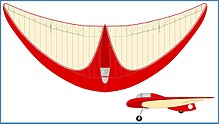Hoarding parable
| Hoarding parable | |
|---|---|
| Type: | Glider |
| Design country: | |
| Manufacturer: | |
| First flight: |
Never flown |
| Number of pieces: |
1 prototype |
The Horten parabola was a flying wing - glider , which in 1938 by the brothers Horten was built. A flight test could no longer be carried out due to weather-related damage that occurred in the winter of 1938/39.
history
The Horten parabola was built in 1938 by the Horten brothers to continue their research to reduce the center effect . With the center effect, they found that the calculated center of gravity led to an increasingly top-heavy behavior of the aircraft with increasing speed. The phenomenon was already investigated with the Horten H Va . This had a wing leading edge divided into four straight segments, which was modified in the parabola in a continuous course without kinks. For the hoarding parable , the seed leaf of the Zanonia served as a model, as in some of the previously built flying wings.
In the winter of 1938 the structure of the flying wing changed so much due to the weather that it was no longer airworthy. According to another source, the aircraft was not flown because the wing loading of 5 kg / m² was so low that it could not be included in any competitive formula. The theory that the parabola broke on the transport to the Rhön competition in 1938 is also published. According to Green & Swanborough, the parabola was only stored after the accident during transport to a test airfield over the winter and suffered further damage in the process. The Horten brothers then burned the unique specimen and finished development work on the parable . A flight test did not take place.
construction
The flying wing was in the shape of two parabolas with obtuse vertices that meet at the ends of the wings. The only recognizable elevation of the flying wing was the single-seat, closed cockpit , whereby the pilot was supposed to steer the aircraft lying down and only the head protruding into the cockpit fairing. The plan of the plane was very similar to the shape of the Zanonia seed.
Technical specifications
| Material wing | Wood |
| Material cockpit | steel |
| crew | 1 |
| Max. speed | 164 km / h * |
| Landing speed | 30 km / h * |
| Position of the pilot | Sitting |
| span | 12 m |
| surface | 33 m² |
| Empty mass | 90 kg |
| Maximum payload | 80 kg * |
| Total mass | 170 kg |
| Wing loading | 5.15 kg / m² * |
* = planned or calculated data, since the Horten parabola was never flown
literature
- Rudolf Storck: Flying Wings. Bernard & Graefe Verlag, Bonn 2003, ISBN 3-7637-6242-6 .
- Heinz J. Nowarra : The German Air Armament 1933-1945. Volume 3. Bernard & Graefe, Koblenz 1993, ISBN 3-7637-5467-9 .
Web links
- http://www.sailplanedirectory.com/horten.htm
- http://nurflugel.com/Nurflugel/Horten_Nurflugels/horten_nurflugels.html
Individual evidence
- ↑ Description of the investigations with the Horten Va
- ^ Rudolf Storck: Flying Wings. 2003, p. 87.
- ^ Heinz J. Nowarra: The German Air Armament 1933-1945. Volume 2. 1993, p. 39.
- ^ William Green, Gordon Swanborough: Horten Exotica .. to the H IX and beyond. In: AIR Enthusiast Thirty-nine. P. 6
